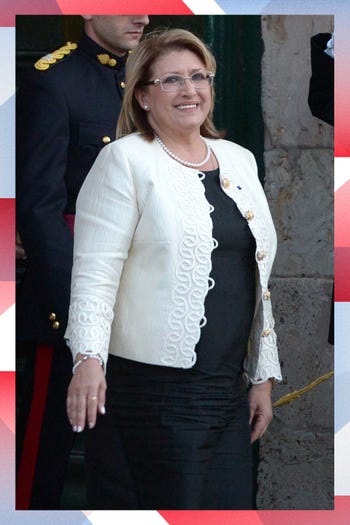Clik here to view.
 The world is made up of close to 200 countries. Fewer than 20 are led by a woman who was elected to the role.
The world is made up of close to 200 countries. Fewer than 20 are led by a woman who was elected to the role.Many nations, including the United States, have never voted a woman into their highest office. As it stands today, 17 women are serving in elected head of state or head of government roles, according to UN Women's count. And it's not just heads of state and government that fall short in a count of women in power. On average, 22% of seats in parliaments worldwide were filled by women as of last year.
While the numbers have improved in recent decades — the percentage of women in parliaments nearly doubled between 1995 and 2015, according to UN Women— the world still has a long way to go before the makeup of political bodies and leadership reflects the population as a whole.
"We need to speed up," Begona Lasagabaster, chief of the leadership and governance section for UN Women, told Refinery29. "It’s painfully slow."
Greater representation by women in political office "reflects the reality of a society," and, more importantly, sparks discussion and policies that promote gender equality across government and society as a whole, Lasagabaster said.
"The fact that we are talking, we are raising and presenting different things obliges men to think about these issues," she said. "[Women] bring their reality, their different nature of thinking, but in the end, they [also] oblige the institution [to change.]"
Lasagabaster knows firsthand the impact that getting more women involved in politics can make. When she was elected to the Spanish Parliament in 1996, she estimates that fewer than 20% of the seats were held by women. By the time she left office 12 years later, they made up nearly a third of the body.
“You could see the difference, you could feel the difference," she recalled. "The fact that we had a critical mass meant we were talking about things that maybe we wouldn't think about [without female members of parliament], like [tax rates] of basic hygiene products of women."
There are many barriers keeping more women from being elected worldwide. Support and interest from political parties, media, funders, and the population at large can be difficult to secure. In some places, female candidates are targeted with threats and violence. And election systems like the one here in the U.S. can create tough paths to victory for female politicians.
"It’s very hard for women to break through in that electoral system that pits candidate against candidate, especially when the electorate might be biased and not vote for women or have perspectives around the role of women in politics which disadvantage them," Julie Ballington, UN Women's policy advisor on political participation, told Refinery29.
Some institutional efforts aimed at getting more women in office, including quotas or commitments to gender equality embraced by post-conflict countries as they reshape their political systems, have helped. But even countries that have made strides in electing female candidates sometimes suffer setbacks.
“It’s a continued battle to sustain the numbers and to increase them, as well," Ballington said.
Still, there have been some bright spots. The Marshall Islands, for example, elected its first female leader in history earlier this year. And, should Hillary Clinton win the Democratic nomination, the United States could have its first real shot at putting a woman in the White House later this year.
Ahead, a look at the 17 women currently serving as an elected head of state or head of government. Check back for updates when more progress is made in the push for gender parity in politics worldwide.
Image may be NSFW.
Clik here to view.

The Marshall Islands — President Hilda Heine
Elected: 2016
Clik here to view.

San Marino — Captain Regent Lorella Stefanelli
Elected: 2015
Clik here to view.

Nepal — President Bidhya Devi Bhandari
Elected: 2015
Clik here to view.

Namibia — Prime Minister Saara Kuugongelwa-Amadhila
Elected: 2015
Clik here to view.

Republic of Mauritius— President Bibi Ameenah Firdaus Gurib-Fakim
Elected: 2015
Clik here to view.

Croatia — President Kolinda Grabar-Kitarovic
Elected: 2015
Clik here to view.

Poland — Prime Minister Beata Szydło
Elected: 2015
Clik here to view.

Central African Republic — Head of the Transitional State Catherine Samba-Panza
Elected: 2014
Clik here to view.

Malta — President Marie Louise Coleiro Preca
Elected: 2014
Clik here to view.

Chile — President Verónica Michelle Bachelet
Elected: 2014
Clik here to view.

Norway — Prime Minister Erna Solberg
Elected: 2013
Clik here to view.

South Korea —President Park Geun-Hye
Elected: 2013
Clik here to view.

Brazil — President Dilma Vana Linhares Rousseff
Elected: 2011
Clik here to view.

Lithuania — President Dalia Grybauskaitė
Elected: 2009
Clik here to view.

Bangladesh — Prime MinisterSheikh Hasina
Elected: 2009
Clik here to view.

Liberia — President Ellen Johnson-Sirleaf
Elected: 2006
Clik here to view.

Germany — Federal Chancellor Angela Merkel
Elected: 2005
Like what you see? How about some more R29 goodness, right here?
Teenage Pregnancy Rates Are At An All Time Low
The Lavish Lives Of The Rich Russian Teens Of Instagram
Amazing Women From Around The World Give You Their Best Advice